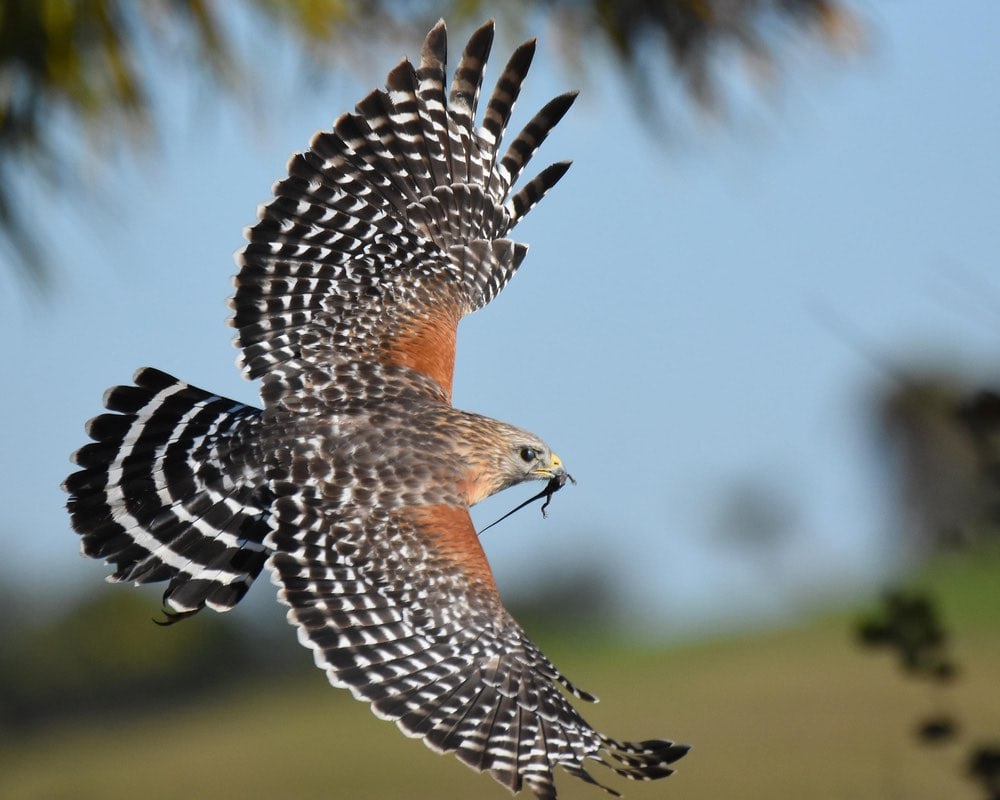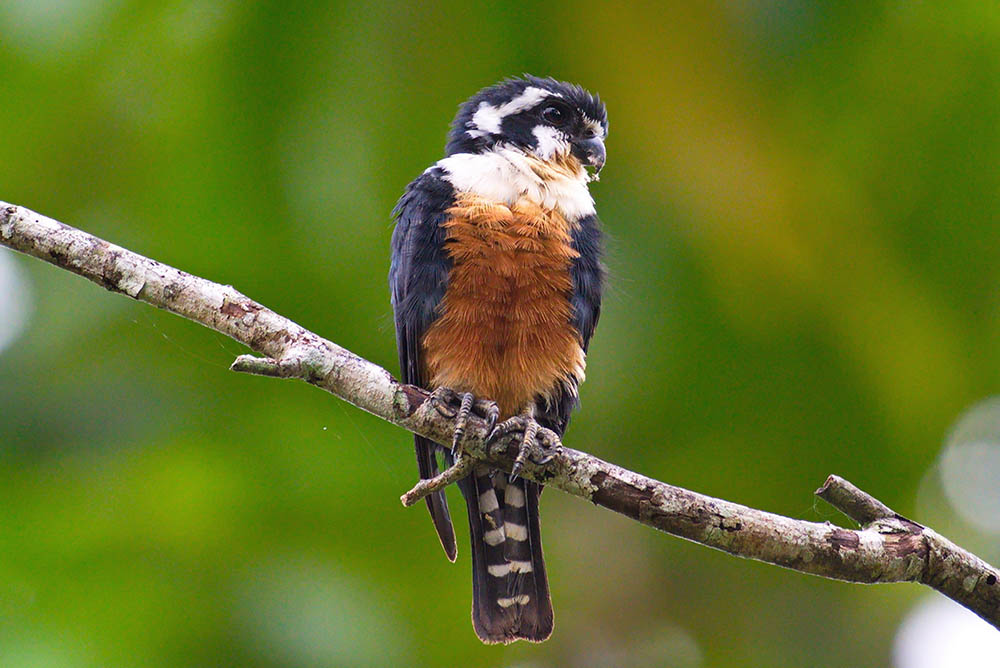Hawk Wingspan: How Big It Is & How It Compares to Other Birds
Last Updated on

The hawk is the type of species that would make you wish you were born a bird. Just think about it. We’re talking about an animal that not only exudes strength, but also power. And that’s not all, as you’ll learn that they are famous for their speeds, particularly while chasing prey.
If we started analyzing all the features that make the hawk such an incredible specimen, we would be forced to pitch camp right here, all day and all night. So instead, we’re just going to focus on one — the wingspan.

The Hawk Family

| Species Name: | Falconiformes |
| Population: | Depends on the species |
| Conservation: | Some endangered, some low risk |
| Range: | found everywhere except Antarctica |
This term ‘Hawk’ does not refer to a specific bird, but an entire family of predatory birds. And this is something that a lot of people aren’t aware of. They think there are just one species of the bird when in essence, there are roughly 270 different species of the hawk. Ornithologists have placed them all in the order Falconiform, which is an order that only comprises swift, graceful bird species characterized by their predatory skill as raptors.
Like every other family out there, the hawk family is different. Yes, they do have quite a few similar features like the keen eyesight, strong bills, and sharp talons, but the broad diversity in their sizes and forms is also evident.
Hawks are often found in deserts and open fields because such habitats make it easier for them to find and capture prey. But that’s not to say that you won’t find other species hovering around the tropical mountains or in moist areas.
The difference in size when you study their sexes is apparent, as the females tend to be larger than the males. The larger species will lay two eggs max, per breeding season, while the smaller ones lay up to five eggs. The incubation period is 3–6 weeks regardless of the species, and both parents are always involved.
Hawk’s Wingspan
The physical differences seen in the male and female hawk is scientifically referred to as sexual dimorphism. And it completely has nothing to do with reproduction.
As stated earlier, the females are always larger than the males in the hawk family. But because we’re talking about a family that has more than one species, we’ll have to start with the smallest hawk and work our way up to the largest.
The tiniest bird in this family is the Black-thighed falconet, and it comes with a 27–32-centimeter wingspan. The largest is the Ferruginous hawk, and it has a 53–56-inch wingspan.
The Black-thighed falconet wingspan

| Wingspan Range | Average Wingspan | |
| Male | 10.6–11.5 inches
27–29 cm |
11 inches
28 cm |
| Female | 10.6 –12.6 inches
27–32 cm |
11.6 inches
29.5 cm |
The Ferruginous hawk wingspan

| Wingspan Range | Average Wingspan | |
| Male | 53–54 inches
134.6–137.2 cm |
53.5 inches
135.9 cm |
| Female | 53–56 inches
134.6–142.2 cm |
54.5 inches
138.4 cm |
How Is Wingspan Measured?
You can easily obtain the measurement from a species that’s still well and alive, or one that has already passed on. If you choose to work with a dead specimen, you’ll have to work fast. Because the minute it gets cold and rigid, you won’t be able to take the right measurement. That elasticity is key for accuracy.
Now, go ahead and measure the length from the tip of one wing to the next and you’ll have your measure.
The second method is our least favorite since you’ll have to wrestle the bird to stay still. This might not be a problem to you or anybody else taking the measurements, because humans are comparatively stronger. But it often hurts the birds.
Measuring the wingspan of a live specimen is different in that you’ll only measure the length from the tip of one wing to the center of the bird’s back. You’ll then multiply whatever figure you get by two, to get the full length.
Fully stretching out the bird is not recommended, as it could result in fatal wounds.
Related Read: Hawk vs Eagle: What’s the Difference? (With Pictures)

Hawk’s Wingspan Compared to Other Birds of Prey
Now, we have the Wandering Albatross as the bird with the largest wingspan in the world. And this is quite frankly, a form of adaptation. You see, if it had a wingspan smaller than 142.7 inches, it wouldn’t have been able to spend most of its life in flight. Because that’s what it does. It’s always up in the air, except for the days that it wants to breed, or when it feels like feeding.
The Great White Pelican is also another remarkable specimen, and a strange one at that. It has features that largely define birds that love spending time in the water, as well as those that are typical of birds of prey — we’re obviously referring to its webbed toes, and long, broad wings.
Its wingspan is 131.65 inches on average, meaning it’s a very large bird.
One of its closest cousins is the Dalmatia Pelican, and it comes in with an average wingspan measurement of 127.9 inches. They both love feeding on fish and spend most of their time in the water.
Finally, we would like to say something small about the Marabou Stork. With an average wingspan measurement of 100.35 inches, it’s clearly an interesting conversation piece. Most of them are found in Africa, and they eat literally anything. they’ll prey on dead animals, plants, and even birds like the Flamingo.

| Wingspan Range | Average Wingspan | |
| Wandering Albatross | 141.7–143.7 inches
360-365 cm |
142.7 inches
362.45 cm |
| Great White Pelican | 119.6–143.7 inches
304-365 cm |
131.65 inches
334.39 cm |
| Dalmatian Pelican | 118.1–137.7 inches
300- 350 cm |
127.9 inches
324.86 cm |
| Marabou Stork | 86.6–114.1 inches
220-290 cm |
100.35 inches
254.88 cm |
Are All Bird Wings the Same?
No, they are not. Birds of the same species have the same type of wings, but those of different species are different. And this should be expected, given they all have different feeding habits, and flying needs.
For example, if you look at the type of wings that the hawk has, you’ll realize they are way different from those of the Wandering Albatross. The latter has long, narrow wings that help it navigate air currents, while the former has slightly wider wings that help it take advantage of thermals — Thermals refer to the hot air rising, as a result of the ground heating up.
Because the Wandering Albatross’ wings are long and narrow, they don’t have to deal with too much air resistance while flapping their wings. And that’s how they can converse energy.
Conservation of energy is also the goal of the hawk, and that’s why they have broad wings that create slots that trap thermals. So instead of flapping their wings every time, they’ll use those thermals to soar up high.
The other influencing factor is their feeding habits. The hawk’s wings give it the ability to catch prey on the ground or in the air, while that of the Albatross gives it a streamlined shape that makes it easier for it to catch prey in water.
Related Read: Male vs. Female Red-tailed Hawks: Spotting the Differences

In Conclusion
And that’s all we had to share with you guys, today. We hope you know we’re always excited to hear from you, so if by any chance you have something to add, don’t hesitate to reach out. Also, some of the species and subspecies in the hawk family have been classified as endangered, so we would really appreciate it if you helped us fight the persecution of these birds.
Featured Image Credit: MTKhaled, Shutterstock
About the Author Robert Sparks
Robert’s obsession with all things optical started early in life, when his optician father would bring home prototypes for Robert to play with. Nowadays, Robert is dedicated to helping others find the right optics for their needs. His hobbies include astronomy, astrophysics, and model building. Originally from Newark, NJ, he resides in Santa Fe, New Mexico, where the nighttime skies are filled with glittering stars.
Related Articles:
How to Collimate Binoculars: 9 Expert Tips
Binocular Magnification Chart: Numbers & Distances Compared
How to Clean a Refractor Telescope: Step-by-Step Guide
How to Clean a Telescope Eyepiece: Step-by-Step Guide
How to Clean a Rifle Scope: 8 Expert Tips
When Were Binoculars Invented? History, Today & Future
Monocular vs Telescope: Differences Explained (With Pictures)
Can You Use Binoculars to Look At Stars? How to Choose the Right Pair
